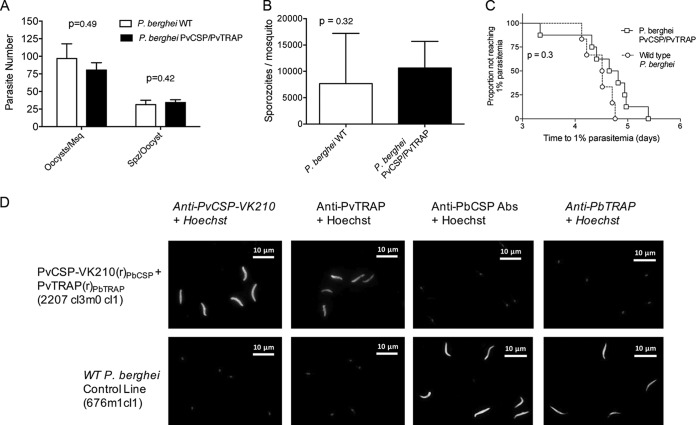FIG 1.
Parasite fitness and phenotype characterization of a double-transgenic P. berghei parasite expressing Plasmodium vivax CSP-VK210 and TRAP. The ability of the PvCSP-VK210/PvTRAP double-transgenic parasite to develop in the invertebrate host was evaluated. (A) Ten days after feeding on infected mice, mosquito midguts were obtained, and oocysts were enumerated for both wild-type and PvCSP-VK210/PvTRAP 2207 cl3m0cl1 parasites. (B) Twenty-one days after feeding, salivary gland sporozoites were extracted and enumerated, and the numbers of sporozoites per mosquito was compared between wild-type and PvCSP-VK210/PvTRAP 2207 cl3m0cl1-infected Anopheles stephensi. Data are shown as means with standard deviations, and P values from t tests. (C) The ability of 2207 cl3m0cl1 to infect vertebrate hosts was evaluated by injecting salivary gland sporozoites into naive BALB/c mice (n = 6) and monitoring for blood stage infection. Outcome is shown as the time to reach 1% blood stage parasitemia. A Mantel-Cox test was performed between groups. (D) Transgenic salivary gland sporozoites were stained with anti-PvCSP-VK210, polyclonal anti-PvTRAP, or with serum from vaccinated mice with ChAd63-MVA expressing PvTRAP or PbTRAP. Alexa Fluor 488-labeled anti-mouse IgG and Hoechst-33342 (nuclear staining) were also included for the assay. As a control, wild-type (WT) P. berghei sporozoites were stained with the same antibodies. Merged images of the different channels are shown for both transgenic and WT P. berghei stained images.

